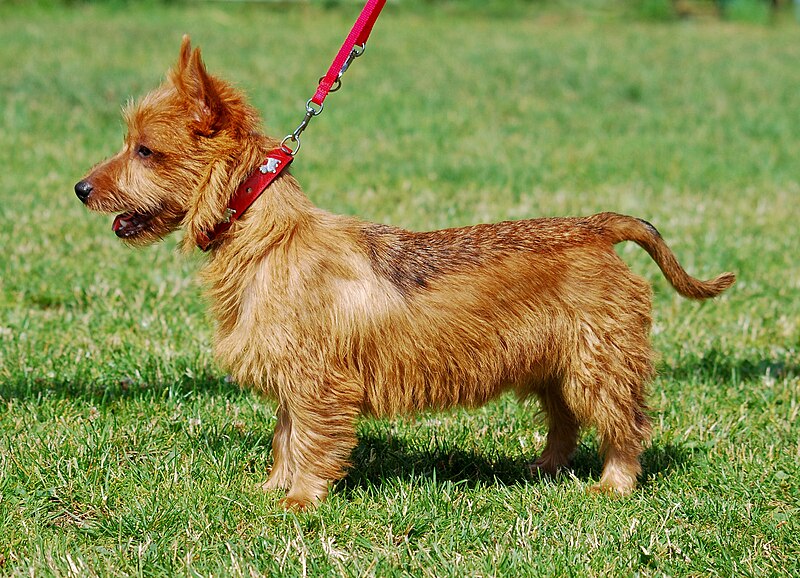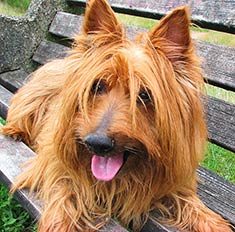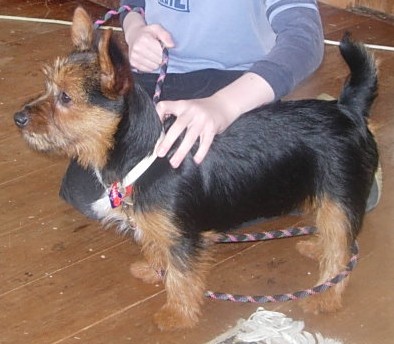 |
| Australian Terrier dog |
The Australian Terrier is a small sized breed of dog of the terrier dog type. The breed was developed in Australia, although the ancestral types of dogs from which the breed descends were from Great Britain.
Appearance
The Australian Terrier is a small dog with short legs, weighing around approx. 6.5 kg (14 lbs) and standing about 25 cms (10 ins.) at the withers, with a medium length shaggy harsh double coat that is not normally trimmed. Fur is shorter on the muzzle, lower legs, and feet, and there is a ruff around the neck. The coat colours are shades of blue or red with a lighter coloured topknot, and with markings on face, ears, body and legs of a colour described in the breed standard as "tan, never sandy". The tail was traditionally docked. As with most pet dog breeds, all proportions and aspects of the body and head as well as colours and markings are extensively described in the breed standard.
History
The Australian Terrier is descended from the rough coated type terriers brought from Great Britain to Australia in the early 1800s. The ancestral types of all of these breeds were kept to eradicate mice and rats. The Australian Terrier shares ancestors with the Cairn Terrier, Shorthaired Skye Terrier, and the Dandie Dinmont Terrier; Yorkshire Terriers and Irish Terriers were also crossed into the dog during the breed's development.
Development of the breed began in Tasmania about 1820, and the dogs were at first called the Rough Coated Terrier. The breed was officially recognised with the founding of the first breed club in 1887, and the breed was recognised as the Australian Terrier in 1892. The Australian Terrier was shown at a dog show for the first time in 1903 in Melbourne, and was also shown in Great Britain about the same time. The Kennel Club (UK) recognised the breed in 1933. The American Kennel Club recognised the Australian Terrier in 1960, and the United Kennel Club (US) in 1969. It is now recognised by all of the major kennel clubs in the English speaking world, and also is listed by various minor kennel clubs and other clubs and registries.
Development of the breed began in Tasmania about 1820, and the dogs were at first called the Rough Coated Terrier. The breed was officially recognised with the founding of the first breed club in 1887, and the breed was recognised as the Australian Terrier in 1892. The Australian Terrier was shown at a dog show for the first time in 1903 in Melbourne, and was also shown in Great Britain about the same time. The Kennel Club (UK) recognised the breed in 1933. The American Kennel Club recognised the Australian Terrier in 1960, and the United Kennel Club (US) in 1969. It is now recognised by all of the major kennel clubs in the English speaking world, and also is listed by various minor kennel clubs and other clubs and registries.
Health
There are three completed health surveys for Australian Terriers. Two surveys, one in 1997 and one in 2002, have been conducted by the Australian Terrier Club of America. The Club is currently collecting data for their next survey. The UK Kennel Club has a 2004 survey, but it has a much smaller sample size than the Australian Terrier Club of America surveys. Some of the respondents in the American surveys were from Australia, but there is no separate Australian health survey.
Mortality
In both 1997 and 2002 Australian Terrier Club of America surveys, median longevity of Australian Terriers was 11 years (total sample size of 230 deceased dogs). In the Kennel Club (UK) 2004 survey, median longevity was 12.1 years, but the sample size was only 11 deceased dogs. 11 years is a typical median longevity for purebred dogs in general, but on the low end of longevities for breeds similar in size to Australian Terriers.
Major causes of death in the 2002 survey were cancer (67%), old age (17%), undetermined (16%), and diabetes (13%).
Morbidity
Among 619 living dogs in the 2002 Australian Terrier Club of America survey, the most commonly reported health problems were endocrine (primarily diabetes), allergic dermatitis, and musculoskeletal (primarily luxating patella and ruptured cranial cruciate ligament). Other conditions reported among more than 4% of the surveyed dogs were adult onset cataracts and ear infections. The much smaller 2004 UKC survey, with 28 living dogs, suggested similar health concerns.
The breed standard describes the ideal Australian Terrier temperament as spirited, alert, "with the natural aggressiveness of a ratter and hedge hunter". Aussies rank 34th in Stanley Coren's The Intelligence of Dogs, being of above average "Working and Obedience" intelligence, indicating good trainability.
Temperament
The breed standard describes the ideal Australian Terrier temperament as spirited, alert, "with the natural aggressiveness of a ratter and hedge hunter". Aussies rank 34th in Stanley Coren's The Intelligence of Dogs, being of above average "Working and Obedience" intelligence, indicating good trainability.
As with other terriers, they can be dog-aggressive and somewhat bossy, and care must be taken when living in a multi-pet household. In general, adult male terriers do not get along well with other adult male dogs. Since the Australian Terrier was also bred for companionship, they tend to be very people friendly, and enjoy interacting with people.
The Australian Terrier is a tough, cheeky little fellow with courage that reminds people of a much larger dog. It has boundless energy and is very loyal, showing great affection for its immediate family and its extraordinary intelligence makes it a responsive and very protective companion. It is an alert, amusing and loveable little dog. Spirited, curious, and self-assured, it has very keen hearing and eyesight, making an excellent watchdog. It wants to please its master and is more easily obedience trained than most other terriers. This breed is not snappish. It likes to bark, and must be told after they first alert you of something, enough is enough, no more barking. An Australian Terrier who is pack leader of it's humans may snap at children. Children need to be taught how to be kind to the dog, but also how to be the dogs leader. They are friendly with other dogs as well as other pets. However they may chase small animals outside the house and should be in a safe area at all times. Socialize this breed well. This is a good dog to travel with. The training of the Australian Terrier needs to be strict because this self-confident dog prefers to follow its own ideas, although they learn very quickly. The Australian Terrier is a very economical breed to feed. Make sure you are this dog's firm, confident, consistent pack leader to avoid Small Dog Syndrome, human induced behavior problems, along with territorial issues. Always remember, dogs are canines, not humans. Be sure to meet their natural instincts as animals.
The Australian Terrier is a tough, cheeky little fellow with courage that reminds people of a much larger dog. It has boundless energy and is very loyal, showing great affection for its immediate family and its extraordinary intelligence makes it a responsive and very protective companion. It is an alert, amusing and loveable little dog. Spirited, curious, and self-assured, it has very keen hearing and eyesight, making an excellent watchdog. It wants to please its master and is more easily obedience trained than most other terriers. This breed is not snappish. It likes to bark, and must be told after they first alert you of something, enough is enough, no more barking. An Australian Terrier who is pack leader of it's humans may snap at children. Children need to be taught how to be kind to the dog, but also how to be the dogs leader. They are friendly with other dogs as well as other pets. However they may chase small animals outside the house and should be in a safe area at all times. Socialize this breed well. This is a good dog to travel with. The training of the Australian Terrier needs to be strict because this self-confident dog prefers to follow its own ideas, although they learn very quickly. The Australian Terrier is a very economical breed to feed. Make sure you are this dog's firm, confident, consistent pack leader to avoid Small Dog Syndrome, human induced behavior problems, along with territorial issues. Always remember, dogs are canines, not humans. Be sure to meet their natural instincts as animals.
Description
The "Aussie," as it is affectionately known, is one of the smallest in the Terrier Group. The Australian Terrier is a sturdy, short legged, little dog. It has a long head, with erect, v-shaped ears and the eyes are dark brown with a keen expression. The nose is black with an inverted V-shaped area above it. The teeth are good sized and should meet in a scissors bite. The body is a little longer than it is tall with a level topline. The chest is deep, set well under the body. The feet are small, and catlike. Toes are arched and compact, nicely padded turning neither inward nor outward. The nails are black. When an Aussie puppy is a few days old the dewclaws are usually removed. The Australian Terrier has a weatherproof double coat that is about 2-3 inches (5-6.5 cm.) long. Coat colors include blue and tan, solid sandy and solid red. Shades of blue include dark blue, steel-blue, dark gray-blue, or silver-blue. In the silver-blues, each hair carries blue and silver alternating with the darker color at the tips. There is a topknot covering only the top of the skull, with a finer and softer texture then the rest of the coat.
Height, Weight
Height: 9-11 inches (23-28 cm.)
Weight: 9-14 pounds (4-6 kg.)
Health Problems
Generally healthy.
Living Conditions
The Australian Terrier is good for apartment living. It is fairly active indoors and will do okay without a yard provided it is taken for walks on a lead. They should not be allowed to roam free because they have a tendency to chase.
Exercise
The Australian Terrier is an adaptable little dog, which needs to be taken on a daily walk. They enjoy the chance to romp and play in a safe area.
Life Expectancy
About 15 or more years
Litter Size
Average of 4 Puppies
Grooming
The stiff, long, shaggy coat is easy to care for and does not need clipping. Simply brush several times a week, being gentle with the soft undercoat. Brushing stimulates natural oils and will soon bring the coat to a high gloss. Because the breed standard is for a hard coat, don't wash this Terrier too often - any more than about once a month will make the coat lank. The coat should be brushed while it dries. Be sure to trim around the eyes and ears, if necessary, with blunt-nosed scissors. It also requires plucking about every three months. The nails should be clipped regularly. The Australian Terrier sheds little to no hair.
Origin
Developed in Australia, and one of the smallest working terriers, the Australian Terrier was first shown as the Australian Rough-Coated Terrier in 1868 in Melbourne, Australia. Officially recognized in 1933, the breed was probably created by crossing many Terrier breeds including the Irish, Cairn Terrier, Norwich Terrier, Dandie Dinmont Terrier, Yorkshire Terrier, and the Skye Terriers. He was used for rodent and snake control, as a watchdog, and even as a shepherd and as a companion. The Australian Terrier was the first breed to be recognized as native to Australia in 1868. It was first recognized by the AKC in 1960. Some of the Australian Terrier's talents are watchdog, tracking, agility, and performing tricks.
Group
Terrier, AKC Terrier
Recognition
FCI, AKC, UKC, KCGB, CKC, ANKC, NKC, NZKC, ATCSA, CET, CKC, APRI, ACR, DRA



No comments:
Post a Comment